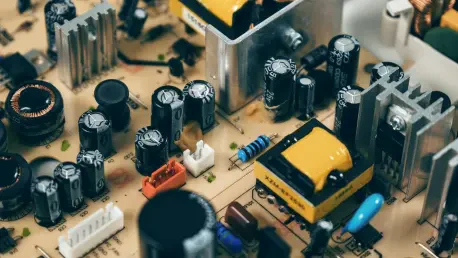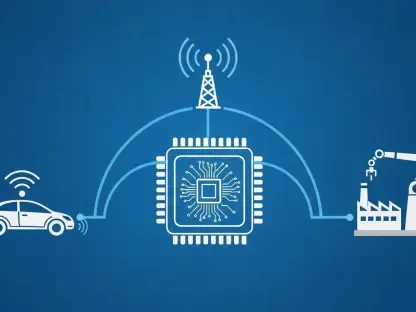In an era where technology evolves at a breathtaking pace, a remarkable innovation from Cornell University is set to redefine the boundaries of artificial intelligence (AI) and wireless communication with the introduction of the microwave brain chip. This cutting-edge microchip integrates high-speed computation and wireless data transmission into a single, energy-efficient device, drawing inspiration from the neural networks of the human brain. Unlike conventional systems that rely on outdated digital processing methods, this chip harnesses microwave technology to achieve unprecedented efficiency and adaptability. The implications are staggering—envision a smartwatch that processes complex AI algorithms locally without draining its battery or depending on cloud servers. This breakthrough isn’t merely an incremental step forward; it represents a fundamental shift in how devices interact with data and networks. By addressing critical challenges in power consumption and performance bottlenecks, the microwave brain chip promises to transform industries ranging from wearable tech to advanced security systems. As the demand for faster, more sustainable solutions intensifies, this tiny powerhouse could be the key to unlocking a new frontier in connectivity and intelligence.
Breaking New Ground with Design Innovation
The microwave brain chip distinguishes itself through a revolutionary approach to data handling that sets it apart from traditional technology. Rather than depending on binary logic gates and synchronized clocks, which dominate conventional digital systems, this chip employs microwave physics to manipulate amplitude, phase, and frequency for processing and transmitting information at gigahertz speeds. Integrated with a neural network, it emulates the learning capabilities of the human brain, allowing it to adapt to new tasks and recognize patterns with remarkable precision. This fusion of advanced physics and AI enables the chip to perform computation and communication simultaneously, a feat that drastically enhances operational efficiency. Such a design not only boosts speed but also redefines what’s possible in compact hardware, offering a glimpse into a future where devices are smarter and more autonomous.
Energy efficiency stands as another hallmark of this groundbreaking technology, with the chip consuming less than 200 milliwatts of power. This is a stark contrast to traditional digital systems, which often require over 500 milliwatts to achieve similar results. The significant reduction in energy use doesn’t come at the expense of performance; instead, it positions the chip as a sustainable solution for a world increasingly focused on minimizing environmental impact. By integrating these capabilities into a single microchip, the developers have created a tool that could fundamentally alter the landscape of wireless tech, paving the way for innovations that prioritize both power and practicality in equal measure.
Addressing the Limits of Modern Wireless Systems
Current digital wireless networks, while foundational to today’s tech ecosystem, face mounting challenges that hinder their ability to keep pace with escalating demands. High energy consumption, the constant need for hardware upgrades, and persistent data processing bottlenecks plague these systems, especially as applications like cloud-based AI and real-time analytics require ever-faster communication. These limitations create a pressing need for alternative approaches that can deliver reliable connectivity without the burden of sprawling, power-intensive infrastructure. The strain on existing networks is evident in everything from sluggish response times to the environmental cost of maintaining large-scale server farms, underscoring the urgency for a transformative solution.
Enter the microwave brain chip, which offers a compelling answer to these pervasive issues by reimagining how data is handled at the hardware level. Its ability to process information locally with minimal reliance on external networks reduces latency and eases the load on centralized systems. This localized approach not only promises faster, more dependable connections but also diminishes the need for frequent, costly upgrades that have long been a staple of wireless tech. By tackling these core inefficiencies, the chip stands poised to alleviate the pressure on modern networks, potentially reshaping the architecture of connectivity for a wide array of applications and industries.
Compact Size Meets Unmatched Efficiency
A standout feature of the microwave brain chip lies in its remarkably small form factor, which makes it an ideal candidate for integration into a variety of devices, particularly in the realm of wearable technology. The ability to embed high-performance AI and wireless capabilities into something as compact as a fitness tracker or smartwatch opens up new possibilities for design and functionality. This isn’t just about shrinking components; it’s about enabling powerful computing in spaces where size constraints have historically limited innovation. The chip’s diminutive footprint could lead to a wave of sleeker, more versatile electronics that seamlessly blend into daily life without sacrificing capability.
Equally impressive is the chip’s focus on energy conservation, aligning with the growing emphasis on sustainability in technology development. With power demands significantly lower than those of traditional systems, it offers a path to creating devices that last longer on a single charge while reducing overall energy footprints. This efficiency is particularly crucial for portable gadgets, where battery life often dictates user experience. By prioritizing low power consumption without compromising on performance, the microwave brain chip addresses a critical pain point, setting a new standard for what consumers can expect from their tech. It’s a step toward a greener future where high functionality and environmental responsibility go hand in hand.
Performance That Rivals the Giants
Testing of the microwave brain chip has yielded results that highlight its potential to compete with established systems, even at this early stage of development. With an 88% accuracy rate in classifying multiple types of wireless signals, the chip holds its own against much larger, more expensive digital setups that dominate the market. This level of precision is achieved with real-time adaptability, thanks to built-in tuners and signal shifters that allow for customization without any noticeable drop in effectiveness. Such flexibility ensures that the technology can be tailored to specific needs, making it a versatile option for a range of demanding applications where reliability is paramount.
Although its accuracy falls slightly short of the roughly 90% benchmark set by top-tier digital systems, the trade-offs in terms of power and space savings are impossible to overlook. For scenarios where every bit of energy and physical room counts—think portable devices or constrained environments—the chip delivers a practical alternative that doesn’t require the hefty infrastructure of its competitors. This balance of performance and efficiency suggests a future where high-end capabilities are accessible in smaller, more affordable packages. As refinements continue, the gap in accuracy may narrow, further solidifying the chip’s position as a formidable player in the tech arena.
Transformative Applications Across Industries
The potential applications for the microwave brain chip span a wide array of sectors, each poised to benefit from its unique blend of AI and wireless prowess. In the realm of wearable tech, it could enable devices to run sophisticated algorithms on-site, reducing dependency on cloud servers and enhancing both speed and privacy for users. Beyond personal gadgets, the chip holds promise for AI systems like large language models, where cutting data transmission costs and energy use could drive down operational expenses. Its ability to handle complex tasks in real time also makes it a candidate for advancing radar and tracking technologies, offering precision in fields from transportation to defense.
Security is another area where this technology could make a significant impact, with its capacity to detect signal anomalies instantly. Such functionality could bolster cybersecurity by identifying threats before they escalate, providing a proactive layer of protection in an increasingly connected world. Additionally, the chip’s compact and efficient design aligns with the needs of smart infrastructure, where integrating AI into everyday systems demands minimal power and space. As these applications come into focus over the next 5 to 7 years, the microwave brain chip could redefine standards across multiple industries, driving innovation in ways that address both current limitations and future aspirations.
Looking Ahead to a Connected Future
Reflecting on the journey of the microwave brain chip, it’s clear that this innovation marks a pivotal moment in the evolution of wireless communication and AI integration. Developed by a dedicated team at Cornell University, the chip leverages microwave physics and neural network architecture to deliver high-speed processing and connectivity with unmatched energy efficiency. Its compact design and low power consumption—under 200 milliwatts—set it apart from traditional systems, while an 88% accuracy rate in signal classification proves its competitive edge. Supported by collaborations with entities like the Defense Advanced Research Projects Agency (DARPA), the technology emerges as a beacon of sustainable progress.
Looking forward, the next steps involve scaling this remarkable chip to handle the massive data volumes of modern networks, a challenge that will determine its broader impact. Refining its capabilities to close the narrow accuracy gap with leading digital systems remains a priority, as does exploring integration into mainstream products. Stakeholders across tech sectors should monitor this space closely, investing in research to accelerate market readiness within the projected 5 to 7-year timeline. By fostering partnerships and addressing scalability hurdles, the industry can ensure that this transformative tool reshapes connectivity, making smarter, greener, and more accessible technology a reality for all.









